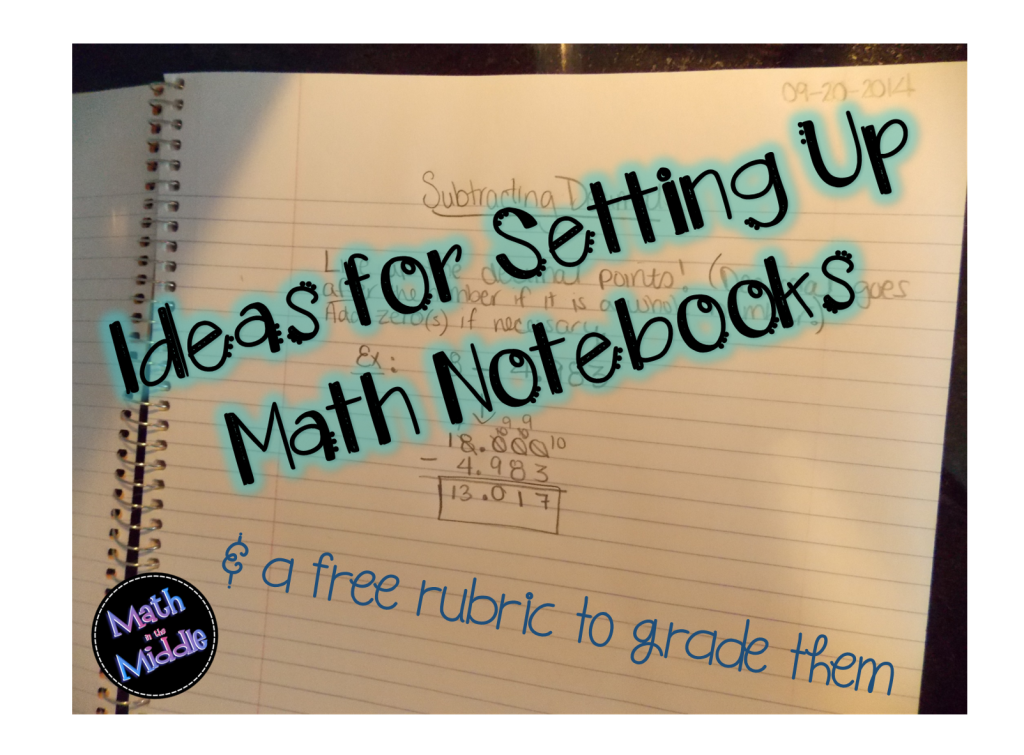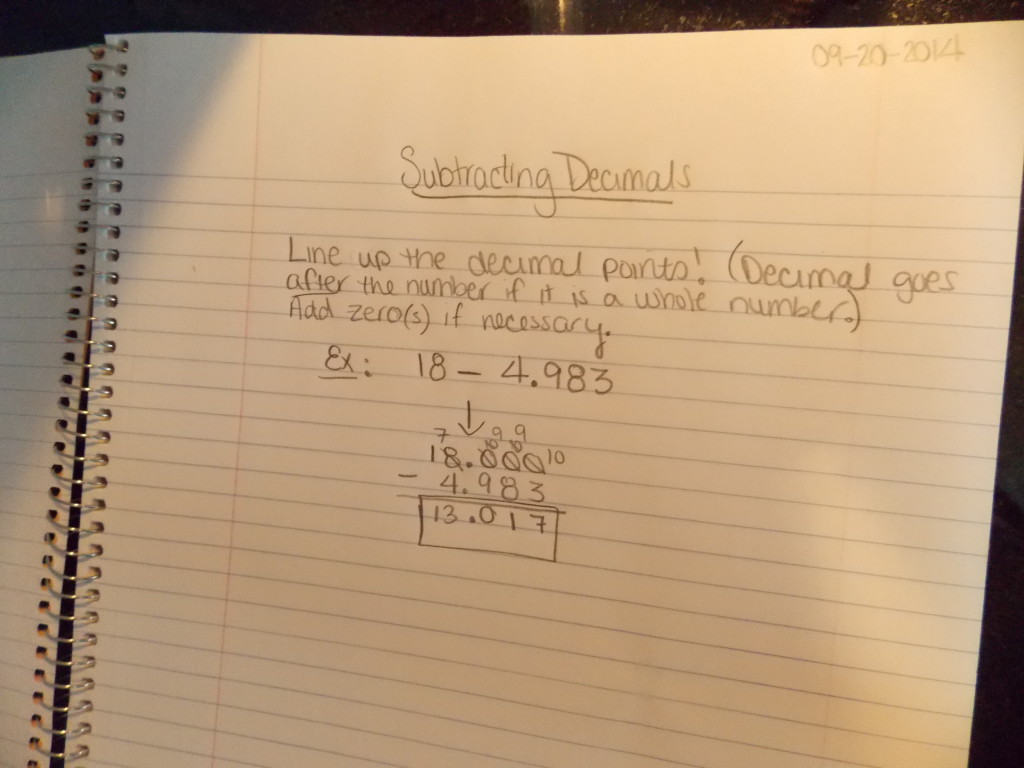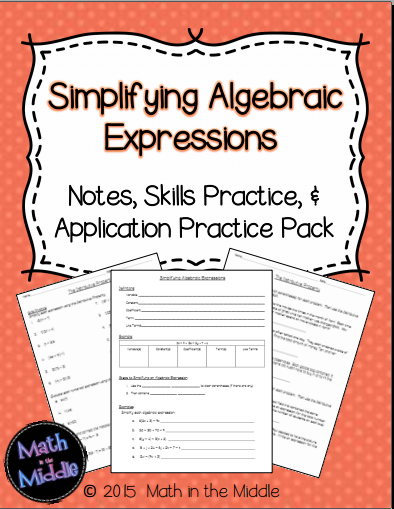With all the buzz on interactive notebooks lately, I thought I’d share how I do notebooks in my math classes for people who are looking for an alternative to cutting and pasting foldables into a notebook.

I have gone back and forth a few times between having my students use binders or notebooks, but for the past few years I have gone with 3-subject spiral notebooks. They are a good size and I like that they have built-in dividers with pockets and the fact that pages can be neatly torn out when needed thanks to the perforation.
The front section of the 3-subject notebook is used for notes. The middle section is for classwork and homework. The back section is used for scrap paper or looseleaf if I want something torn out and handed in. I like to set it up this way so that the front section is a nice, organized resource they can use to refresh their memory on how to do something without having to root through pages of work. (It also makes checking their notes easier when they are all in one place)! I also like the fact that the students are not staring at their notes when they go to do their classwork or homework, so they can try the problems on their own, but they can easily flip back if they need to reference the notes.
Taking notes in my class is mandatory. Each day (in the “notes” section of the notebook), students are required to (1) title the notes with the day’s topic, (2) write the date, (3) write a summary/explanation of how to do the day’s lesson, and (4) give an example, solved correctly and showing all work. Here is a sample of what I expect in a day’s notes for a lesson on subtracting decimals:
I collect notebooks on chapter test days and grade the “notes” section while my students are taking the test. I collect on test days so that students make sure they have all their notes in order (and hopefully look them over) before taking the test and because they obviously don’t need their notebooks while they are taking the test. Notes are worth 20 points per chapter and I grade them using the following rubric:

Click here for the pdf version of my notebook rubric
Click here for the editable version.
Most of my students are pretty good about taking good notes since it is a big part of their grade. They know that simply taking good notes each day in class is an easy way to get a 20/20 averaged into their grade each chapter, which is a good motivator for most students!
For classified students with special note-taking requirements in their IEP’s, I provide guided notes on which they basically just need to fill in the blanks, but the guided notes I give are in the same general format with both explanations and examples each day. I also save the notes I write on my interactive whiteboard each day and share them with my classified students on Google Drive. That way if they weren’t able to finish filling in their note sheets in class, they can fill them in at a later time.
I am in the process of typing up my guided notes and making them a little nicer. (As I complete sets, I am putting them in my TpT store along with practice sheets and application sheets that correspond to the lessons). You can grab my set of notes, practice sheets, and application sheets on simplifying algebraic expressions free for the next few days! Click the image below to get this set while it’s free!
How do you handle note-taking in your math class? I would love to hear ideas from other teachers!
Thanks for reading,
Christina
(Also, all paid items in my TpT store are on sale today, August 19th for 28% off with code MORE15)!!




The curriculum that my school use comes with student notebooks. These are bound paperback books with guided notes for each section of the book. Since it aligns with the textbook curriculum I find this very helpful. These contain guided notes for vocabulary, some practice problems and real-world connections. Students will takes notes from this each day. There are some parts that I’m not a fan of, so we will skip those, and there are blank areas for us to add additional notes that I think are beneficial.
That sounds great to have everything included with your textbook series!
I love the idea to have a notes section in their spiral notebook. I might hang an emoji poster and ask each student to draw the emoji that describes how they feel about the lesson and why. Instant exit ticket with some formative assessment.
That sounds like a really cute idea! Thanks for sharing!! 🙂
Christina:
Does the summary you have the kids write come after the actual notes, or is that the only notes you expect them to take that day? Do you have your notebook already set-up or do you complete a new one each year? Also, if you use worksheets or pass back quizzes/tests or do Please Do Nows or Warm-ups…where do you have the kids put these?
Thanks,
Kim
Hi Kim,
I have actually changed the way I do notebooks since writing this post and this year will be switching to binders so everything will be changing again. I am actually hoping to write a post on my new system soon. However if you look for my post on notebook dividers you can see a little bit of how I set things up last year, and this year will be similar.
Now to answer your questions from this post… I used their summaries as their notes for the day. I have never kept my own notebook. I just write my notes as I go on the board for them. I have an interactive whiteboard I use, so I do save my notes each day to keep a copy of them, but I dont plan them out in advance since I always let class discussion guide my class notes.
I used 3-subject notebooks with pockets in them, so thats where loose pages were kept. I had them empty out old worksheets after each unit, though. Like I said, I will be switching to binders this year, though, so everything will be kept in there.
Hope that helps! And look for a post coming soon for all the details on my plans for this coming year!
Christina:
i have always used binders, but I got a little aggravated with them last year. The students had a lot of trouble putting papers where they belong, and you know some students don’t even put things in the rings…they just keep one BIG stack of everything. Last school year caused me to stop and think if there was a better way. Will you still cut and paste onto a regular sheet of paper or what are your plans? The 3 subject spiral notebook seemed like a great idea for that instead of having a lot of loose papers. Any insight as to why you are going to (or back to) a binder? I am just curious if you plan to be as hands-on and as interactive with the binder.
Looking for any advice…
Thanks again,
Kim
Kim,
I don’t really do many foldables or anything in my notebooks so my format will be the same in the binders…just on looseleaf paper instead of notebook pages. I am planning to change my dividers for the binders – haven’t played around with them much yet, but plan to figure out what I’m doing with them and share in my upcoming blog post. I am going to binders because this year we are switching to a new textbook series that does not include a workbook. In the past I generally assigned a workbook page for homework most nights. This year any homework assignments I give will need to be worksheets, so I thought that with binders I could run off all worksheets I plan to give for a unit in advance so students can keep them in their binders as a mini-workbook and there would be less of a chance of them losing pages.
In terms of the organization issues with binders – I do plan to be on top of the kids about putting things in the right places. I have used binders in the past and have seen that as long as I spend some time teaching and reinforcing my expectations with them at the beginning of the year it isn’t a huge problem. I also decided to go with small binders (1/2 inch) so they will only have their notes for one unit at a time in their in-class binders. My plan is to ask them to keep a 2-3 inch binder at home for all of their older notes and tests/quizzes that are brought back.
If you are considering switching to the 3-subject notebooks, I will say that I loved using them and if not for losing workbooks this year, I would have continued to use them.